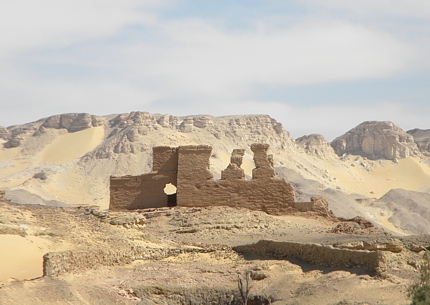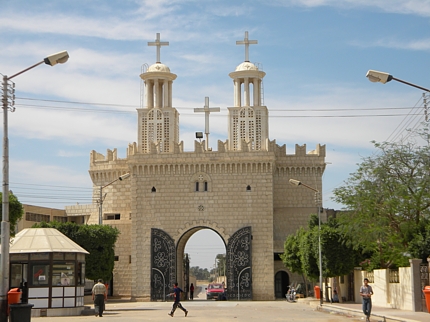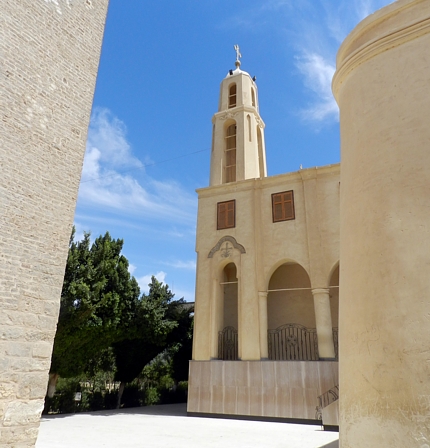
|
| The Location Asyut or Assiut is the capital of the modern Asyut Governorate in Egypt; the ancient city of the same name is situated nearby. The modern city is located Less than 400 kilometers to the south of Cairo, the city of Assiut graces the Nile in the middle of Upper Egypt. Well worth a visit, we recommend you explore the city and the surrounding countryside on a two day visit from Cairo, or as part of a trip that includes Minya and Quena. The Name The name of the city is derived from early Egyptian Zawty (Z3JW.TJ) (late Egyptian, Səyáwt) adopted into the Coptic as Syow. In Graeco-Roman Egypt, it was called Lycopolis or Lykopolis (Greek: Λυκόπολις, "ἡ Λύκων πόλις"),Lycon, or Lyco. The History of Asyout (Assiut) Ancient Asyut Ancient Asyut was the capital of the Thirteenth Nome of Upper Egypt (Lycopolites Nome) around 3100 BC. It was located on the western bank of the Nile. The two most prominent gods of the Ancient Egyptian Asyut were Anubis and Wepwawet, both funerary deities. During the First Intermediate Period, the rulers of "Zawty" (Khety I, Itefibi, and Khety II) were supporters of the Herakleopolitan kings, of whose domain the Nome formed the southern limits. The conflict between this Nome and the southern Nomes under the rule of the Eleventh dynasty ended with the victory of Thebes and the decline of Asyut's importance. The last Ancient Egyptian monuments discovered in Asyut include; the Asyut necropolis (west of the modern city), tombs which date to dynasties Nine, Ten and Twelve, and the Ramessid tombs of Siese and Amenhotep. In Graeco-Roman times, there was a distinct dialect of Coptic spoken in Asyut, known as "Lycopolitan", after the Greek name for the city. Lesser-used names for this dialect are "Sub-Akhmimic" and Assiuti. Modern Asyut Today, the city of Asyut has almost 400,000 inhabitants. It is the Egyptian city with the highest Coptic Christian concentration. It is also home to the University of Assiut, one of the largest universities in Egypt, to the Assiut Barrage, and to the Lillian Trasher Orphanage The Virgin Mary is reported to have appeared in Asyut on 17 August 2000. This apparition is recognized as an official Marian apparition by the Coptic Orthodox Church and remember ed in the Deir el-Muharraq, Monastery of the Virgin Mary. (Citation needed). In more recent times, it was the end of the road for camel caravans that traveled up the 40 Day Road from Darfur in the Sudan, and as late as the 1850's it had the largest slave market in Egypt. Today Assiut is the capital of the Said (Upper Egypt) governorate, has a large Christian community and is the region's most important agricultural center, dealing in cotton and grain. It also has some carpet manufacturing industry. It is also the home of the third largest university in Egypt. Besides the ancient attractions near Assiut, there is also Banana Island, which is a nice place to relax. On the north edge of the City you will find the 19th century English barrage, which was built to control the Nile by regulating the flow of water into the Ibrahimiyya Canal. This Canal is an important source of irrigation water though out the region. Asyut is the terminus of the Ras Shukheir-Asyut oil pipeline, the terminus of the Cairo-Asyut gas pipeline and the beginning of the proposed Asyut-Qena gas pipeline, the last two being part of the Nile Valley Gas Company Pipeline Project. The Climat Its climate as hot desert (BWh). It is the driest city of Egypt. Luxor, Minya, Qena and Asyut have the widest difference of temperatures between days and nights of any city in Egypt, with almost 16 °C (29 °F) difference. The city of Asyut is sandwiched between two mountain ranges of about 600m height. There is also a lowering in elevation in mid Egypt, from the Mediterranean and the Red Sea. This gives the city and nearby towns and villages the similar properties of a continental climate, meaning that the city has harsh and chilly cold winter weather, and very hot but non-humid summers. During summer the temperature can exceed 42 °C (108 °F). Yet, in winter Asyut gets below 0 °C (32 °F) temperatures during the night and frost can easily form, while hail or snow are rare because of the low average of the city's precipitation and general lack of humidity. |
View Larger Map    |
|

What to visit in Asyout (Assiut)? Meer monuments - Quseia town  It’s 65 km far from the city of Assiut. It contains a group of tombs dug in the mountain to be the graveyard of the capital of the old county. The God of Meerwas called “Hatt hour” and the Village itself was called Qees’ in the ancient times, but later-in the Romanian era- was called Qusay It’s 65 km far from the city of Assiut. It contains a group of tombs dug in the mountain to be the graveyard of the capital of the old county. The God of Meerwas called “Hatt hour” and the Village itself was called Qees’ in the ancient times, but later-in the Romanian era- was called QusayThe tombs of Meer are famous for its paintings which were very similar ~9 the, original subjects. Also, the drawings of the ordinary life of the Egyptian worker were accurately recorded on the walls of the tombs. Muharraq Monastery It was a very unique event when the Holy family came to Egypt, and it represents reasonable evident that Egypt is the land of Peace and security. When the Holy Family ran away to Egypt because of the non-human and humiliating treatment of Romans about 2002 years ago, Assiut was one of 26 sites that Jesus’ family stayed in for a long time. The tree that overs had owed the Virgin Maryin Dayrut is still present in Anpa Srapamon monastery. Then, the Blessed family walked to the village Meer where they stayed at the foot of the mountain Qusqam for a whole 6 months and that’s where the Muharraq monastery is located till this moment. Muharraq monastery gathers the oldest church in the Christian world which was built in 38 AD, and that’s where the oldest ‘Admittance Place” Also, in the monas king Xenon in the year monumental church Also, in the monastery lies the fortress of the king Xenon in the year 474A.D.  and there are two monumental churches. Muharrq monastery is surrounded by a 12 meters height fence built in the 4th century. While returning, Jesus’ family passed by the western mountain far from the south-west of Assiut by 10 km and the height of l00 m from the surface of earth .That’s where the family ended its journey, as they stayed in an ancient cave belongs to the year 2500 B.C. Then the family went backto Palestine by the Nile. and there are two monumental churches. Muharrq monastery is surrounded by a 12 meters height fence built in the 4th century. While returning, Jesus’ family passed by the western mountain far from the south-west of Assiut by 10 km and the height of l00 m from the surface of earth .That’s where the family ended its journey, as they stayed in an ancient cave belongs to the year 2500 B.C. Then the family went backto Palestine by the Nile.The Virgin Mary’s monastery in Ganadela monastery Ganadela monastery lies in a big monumental cave in the western mountain, its monuments are concentrated in a number of old caves belong to the 1st century. In this monastery, there are two churches; the first is the Virgin Mary’s church. lit is carved in the rocks and on its walls and ceiling there are some frescos which belong to the 6th century. The second church is the Eastern Church. Its ceiling consists of nine domes, six for the courtyard and three for the temples. Gabrawy Monastery This wonderful site is located in “Gabrawy monastery village”, about 20 km far from the north-east of Assiut, the town. These monuments are a group of tombs carved in the body of the mountain, for the governors and princes of the l2thfamily during the ancient and middle eras. The tombs are divided into southern and northern tombs. The southern are two tombs belong to the middle era, and the northern are located in the eastern mountain, in front of a village called Arab-Atyat. These tombs are famous for what is on its walls of beautiful decorations and naturally colored paintings. The Virgin Mary’s Monastery in Doronka The virgin Mary monastery in Doronka is located on Western Assiut Mountain 100 meters high, and 10km from Assiut city. It has a very ancient cave which was found since 2500 B.C. and from which the Holy Family started their journey back to Palestine, and later on the monastery was made beside-it. Dair Durunka is approximately 50km. south of Dayr Al- Muharraq and 9km. south of Assiut, the historical city of Lycopolis. In the convent we visit a large cave where according to tradition the Holy Family has stayed before taking a boat north, returning to Palestine.  The cave which had been once used as a pharaonic quarry attracts hundreds of thousands of pilgrims yearly. It is known that this monastery is better equipped than any other place on the route of the Holy family to receive large numbers of pilgrims, especially during the festival of the Holy Virgin in August. Many are coming because of repeated apparitions of the Holy Virgin in the past decades. Deir Rifa Some people believe the Holy Family went further south to Dayr Rita, Dayr al-Ganadla and some Ethiopians believe they even went as far as Ethiopia. At Dayr Rifa is an absolutely magnificent Cave church built in a Ptolemaic temple. This location is, however, difficult to visit due to a neighboring army base. Mujahedin Mosque It’s considered as one of the oldest high hanged Egyptian mosques It was built at the ottoman style, and it had a big high minaret. This minaret is quadrangular in shape. The mosque has a separate place for women prayers, and its entrance is decorated by wooden and stony paintings at the ottoman style. It said to be built on the ruins of a Mamluki mosque. Farghal Mosque It’s located in the town of Abou¬teeg, and has two minarets. It’s considered as one of the most famous religious tourist place in the governorate of Assiut. Abueleion Mosque ABUELEION mosque is found in Dayroot and was built by Mr. Ibrahim Abueleion. | ||
|
|
|